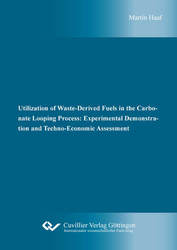| Areas | |
|---|---|
| Serie de libros (96) |
1378
|
| Nachhaltigkeit |
3
|
| Gesundheitswesen |
1
|
| Letra |
2364
|
| Ciencias Naturales |
5406
|
| Ciencias Ingeniería |
1792
|
| Ingeniería | 292 |
| Ingeniería mecánica y de proceso | 862 |
| Ingeniería eléctrica | 686 |
| Mineria y metalurgía | 30 |
| Arquitectura e ingeniería civil | 75 |
| General |
98
|
|
Leitlinien Unfallchirurgie
5. Auflage bestellen |
|
Erweiterte Suche
Utilization of Waste-Derived Fuels in the Carbonate Looping Process: Experimental Demonstration and Techno-Economic Assessment (Tienda española)
Martin Haaf (Autor)Previo
Indice, PDF (740 KB)
Lectura de prueba, PDF (940 KB)
The economic and environmental threat of climate change due to the anthropogenic rise of the
CO2 concentration in the earth’s atmosphere is widely accepted. In addition to the utilization of
renewable energy sources, the application of carbon capture and storage processes in energyintense
industries seems to be unavoidable. This thesis evaluates the utilization of waste-derived
fuels in the calcium looping CO2 capture process. The feasibility of continuous CO2 separation
by means of a waste-derived fuel fired calciner was successfully demonstrated by experimental
investigations in a 1 MWth pilot plant. In these investigations, the boundary conditions were
adapted to an application in Waste-to-Energy plants. Over the course of the test series, it was
shown for the first time worldwide, that CO2 capture rates of more than 90 % are feasible, while
oxyfiring commercially available solid recovered fuels. Based on the experimental data, a
process was validated and subsequently applied for the determination of heat and mass balances
for the retrofit of a Waste-to-Energy plant.
Die wirtschaftlichen und ökologischen Gefahren des Klimawandels aufgrund des
anthropogenen Anstiegs der CO2-Konzentration in der Erdatmosphäre sind weithin anerkannt.
Neben der Nutzung erneuerbarer Energiequellen scheint die Anwendung von Verfahren zur
Abscheidung und Speicherung von CO2 in energieintensiven Industrien unumgänglich. Diese
Dissertation bewertet die Nutzung von Ersatzbrennstoffen im Carbonate-Looping Prozess. Es
konnte die CO2-Abscheidung aus einem MVA-ähnlichen Abgas durch einen EBS-gefeuerten
Kalzinator anhand von experimentellen Untersuchungen im 1 MWth-Maßstab erfolgreich
nachgewiesen werden. Im Rahmen der Versuchsreihen wurde weltweit erstmals gezeigt, dass
CO2-Abscheidungsraten von mehr als 90 % realisierbar sind. Basierend auf den
experimentellen Daten wurde ein Prozessmodell validiert und anschließend zur Bestimmung
von Massen- und Energiebilanzen für die Carbonate-Looping Nachrüstung einer
Müllverbrennungsanlage eingesetzt.
| ISBN-13 (Impresion) | 9783736972292 |
| ISBN-13 (E-Book) | 9783736962293 |
| Formato | A5 |
| Idioma | Inglés |
| Numero de paginas | 188 |
| Laminacion de la cubierta | Brillante |
| Edicion | 1. |
| Lugar de publicacion | Göttingen |
| Lugar de la disertacion | Darmstadt |
| Fecha de publicacion | 07.07.2020 |
| Clasificacion simple | Tesis doctoral |
| Area |
Ingeniería mecánica y de proceso
|
| Palabras claves | Klimawandel,Anstieg der CO2-Konzentration,Erdatmosphäre,CO2-Emissionen,Effizienzsteigerungen,Reduzierung des Energieverbrauchs,erneuerbare Energiequellen,Biomasse,CO2 energieintensiven Industrien,Abgasstrom,Langzeitlagerstätten,Bilanzierung der CO2-Emissionen,CO2-Reduktionen,CO2-Abscheidung,CO2-Abscheideverfahren,CaL-Prozesse,Oxyfuel-Verbrennung,thermische Kraftwerke,Müllverbrennungsanlagen (MVA),Abfallentsorgungsstrategien,organische Abfallfraktionen,klimaneutral,Ersatzbrennstoffe,CaL-Prozessmodell,Energiebilanzen,Stromgestehungskosten,climate change,rise of the CO2 concentration,earth atmosphere,CO2 emissions,efficiency improvements,reduction of energy consumption,renewable energy,biomass,CO2 energy intensive industries,exhaust gas flow,long term deposits,balancing of CO2 emissions,CO2 reductions,CO2 separation,CO2 separation processes,CaL process,oxyfuel combustion,thermal power plants,waste incineration plants,waste management strategies,CaL process model,substitute fuels,energy balance,Carbonate Looping Process, |
| URL para pagina web externa | https://www.est.tu-darmstadt.de/est_est/index.de.jsp |








